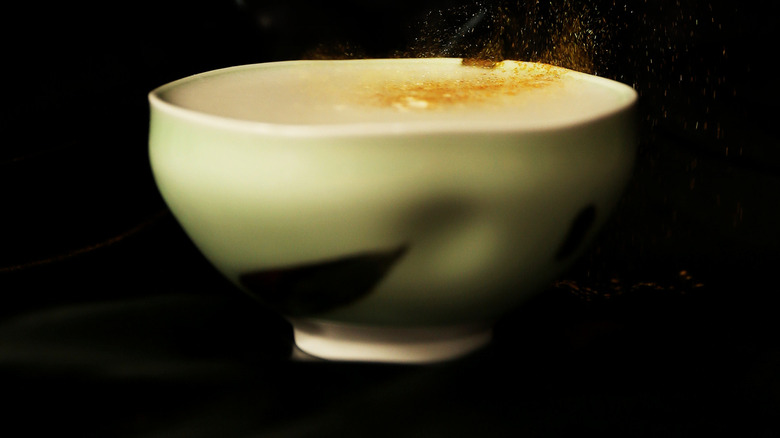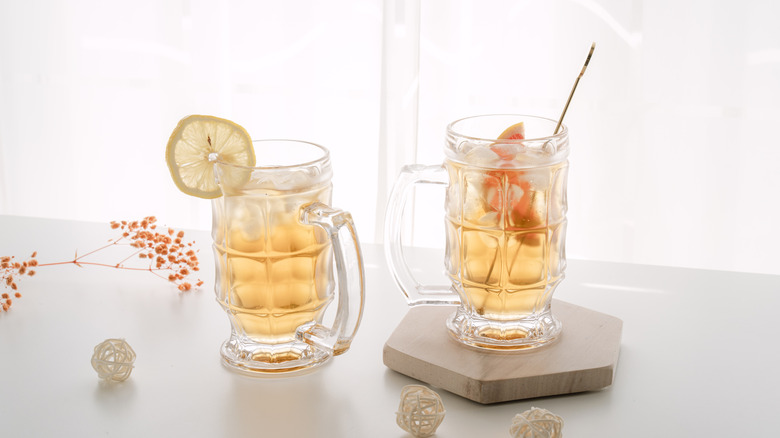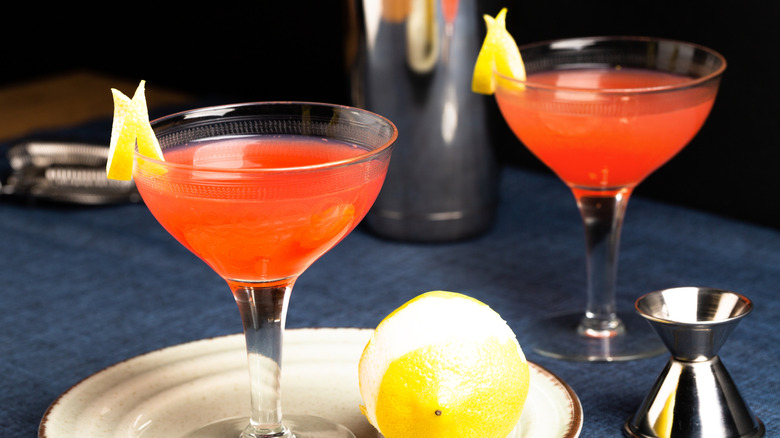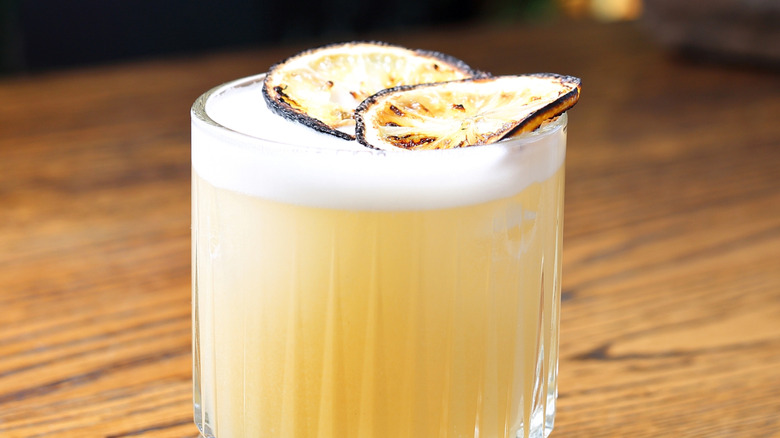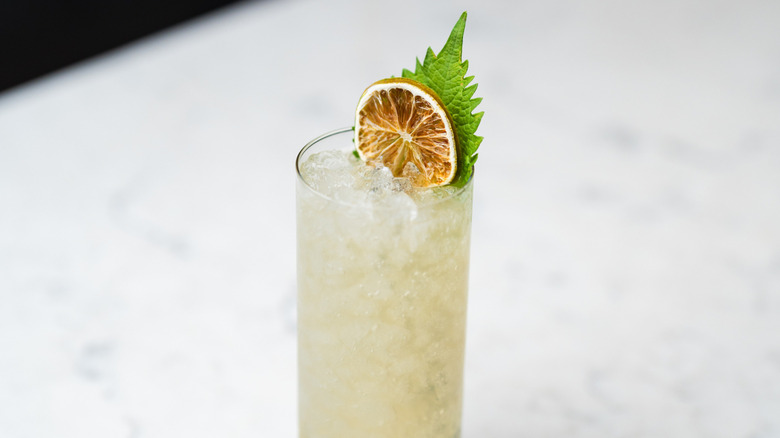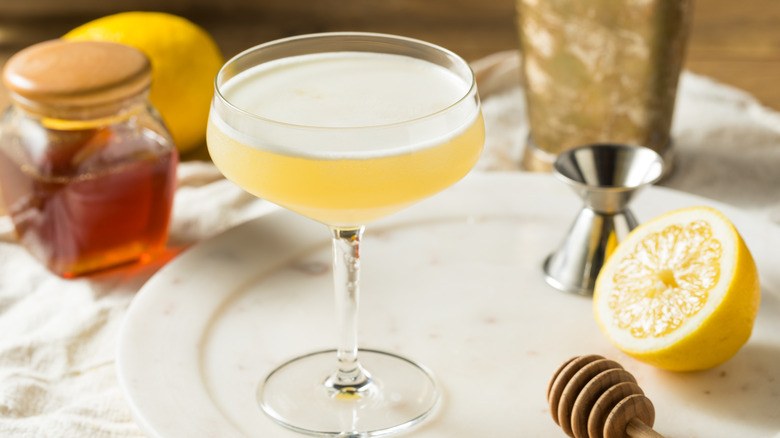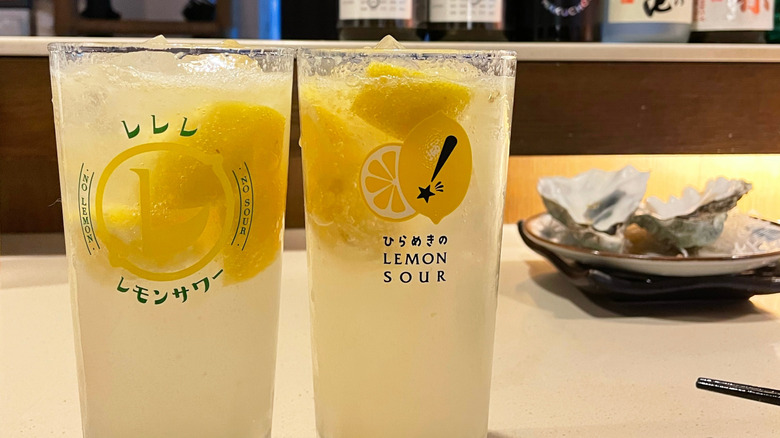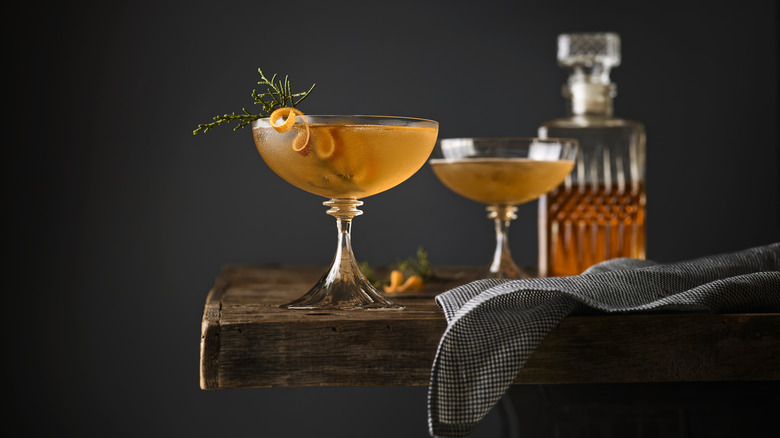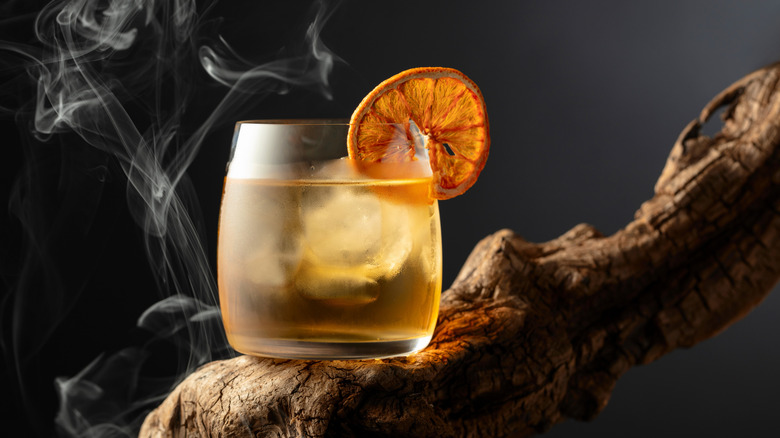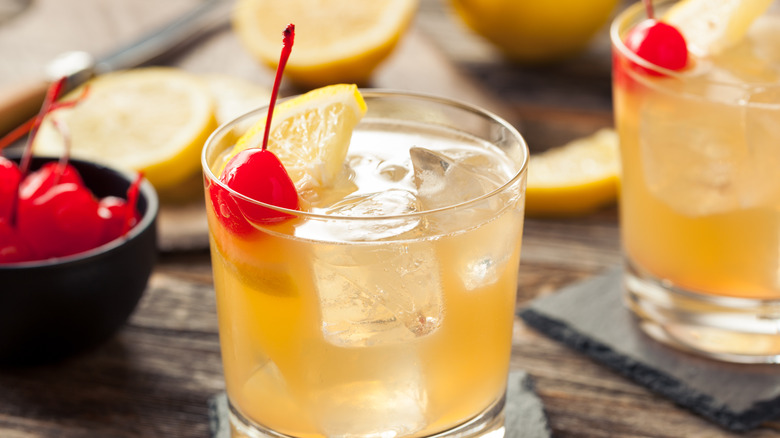9 Absolute Best Cocktails For Japanese Whisky
Japanese whisky has quickly become a darling among both connoisseurs and curious drinkers. (And yes, it's whisky, not whiskey) It's become so popular in North America that you can now find it at Costco. Whether it's the soft grain notes of a Nikka Coffey Grain or the umami-laced complexity of a Takamine, these whiskies aren't just for sipping neat — they're exceptional in cocktails, too. Even Sammy Davis Jr favored it.
What sets Japanese whisky apart isn't just its flavor, but its philosophy. Rooted in "kodawari," the cultural principle of obsessive attention to detail and craftsmanship, and "wa," the pursuit of harmony, Japanese whisky stands in elegant contrast to the bold sweetness of bourbon and the peaty punch of Scotch. Many are aged in Mizunara oak casks, which are renowned for their rarity and complexity but notoriously difficult to work with due to their porous grain. Shaped by soft water, precision distillation, variable climate aging, and reverence for balance, these whiskies embody quality Japanese craftsmanship.
According to Nick Meyer, Regional Beverage Director of the Michelin-starred Aburi Group, Japanese whisky shines best in cocktails when you give it room to breathe. This means not overwhelming it with overtly sweet or acidic ingredients. Exercising restraint through mixology, if you will. Judith Kwong of Sukiyaki House adds that it pairs beautifully with ingredients like yuzu, honey, green tea, ginger, and umami-rich notes like miso or shiso. "Using the zest is also a great way to add citrus without the acidity taking over," she explains.
The Highball
This two-ingredient classic is deceptively simple: whisky and soda. But when done right, it's revolutionary. A perfect highball lets the spirit shine while adding a sparkling lift. Beverage consultant Steven Tseng (@Tseng_StevenMix) explains that the carbonation of soda water brightens the whisky's flavors and makes it more approachable for people who find whiskey too strong. In a cocktail this simple, every ingredient matters, from the clarity of the ice to the effervescence of the bartender-approved soda. It is important to use the most high-quality ingredients. "It's just whisky and soda water, ice cold. Done well, its purity and harmony allow the whisky's subtle complexities to shine through," says Alex Gomez, Bar Manager of Bar Doko.
In Japan, whisky highballs are beloved. They can be found both in vending machines or Michelin-starred cocktail bars. It's the ultimate expression of wa (harmony) in a glass. According to Judith Kwong, "Suntory Toki is perfect for a classic Highball," she elaborates, "If I want to elevate the experience or splurge a little, Akashi White Oak is my go-to for a more whisky-forward version."
To make a highball, pour 2 ounces of Japanese whisky over a large ice cube in a tall, chilled glass. Stir gently to chill, then top with 4–5 ounces of high-quality club soda. Stir once or twice to combine, and garnish with a twist of citrus if desired.
Paper Plane
Inspired by Italian and Japanese flavors, this elegant cocktail pairs smooth Japanese whisky with Amaro Nonino and Aperol for a refreshing boost. The result is bittersweet and zesty, making it great for patio season.
The recommended base spirit for this cocktail is Nikka Coffey Grain, a Japanese whisky known for its smooth and mellow profile. Notes of banana, vanilla, and tropical fruit help taper the bitterness of Aperol and highlight the softer botanical notes in Amaro Nonino. Unlike its blended sister expression, Nikka Days, the Coffey series is distilled in specialty stills, giving them a more rounded mouthfeel. Nozomi Odaohara from Nikka Whisky elaborates that this adds custard cream-like richness to any cocktail. This is a straightforward cocktail that doesn't require complicated techniques or ingredients, which makes it also great for home bartenders.
To make it, shake equal parts of Japanese whisky, Amaro Nonino, Aperol, and fresh lemon juice with ice, then strain it into a coupe glass. Garnish with an origami crane (if you're feeling fancy) or a simple lemon twist.
Whisky Sour
A Japanese twist on the classic whisky sour, the Yuzu Whisky Sour is a cocktail that brings brightness, balance, and a touch of elegance to the glass. The addition of fresh yuzu juice, a Japanese citrus known for its floral aroma and sharp tartness, adds complexity without overpowering the whisky. Alex Gomez elaborates that yuzu heightens the caramel and floral tones of Japanese whiskies. Hibiki Harmony or any blended whisky with a lighter, rounded profile would be the perfect choice for this cocktail.
A blend of malt and grain whiskies aged in a mix of American white oak, Spanish oak, and Mizunara oak, Hibiki Harmony offers a nuanced flavor profile that complements the citrus beautifully. "Its aroma is layered with floral notes — like rose and lychee — with a hint of rosemary," describes Megan Cuff from House of Suntory. In a cocktail, these flavors provide layered aromatics to a simple cocktail. It's great for people new to Japanese whisky who still want a citrus-forward drink.
To make it, shake 2 ounces of Japanese whisky, 3/4 ounces of fresh yuzu juice, and 3/4 ounces of simple syrup together with egg white for texture. Shake over ice, then strain into a chilled coupe and garnish with a twist of citrus peel (ideally yuzu) for an extra aromatic lift.
Tokyo Mule
A Japanese twist on the classic Moscow Mule, the Tokyo Mule blends the warm spice of ginger beer with the delicate sweetness of Japanese whisky, making for a cocktail that's as refreshing as it is nuanced. Where vodka plays it neutral in the original, Japanese whisky, especially something bright like Suntory Toki, adds layers of honey, oak, and subtle spice that elevate the drink to new heights.
This cocktail is especially popular in izakaya-style settings, where diners crave something crisp and crushable to pair with salty, fried bar snacks. At Miku, one of the restaurants under the Michelin-recognized Aburi Group, the Tokyo Mule has become a fan favorite. "The Tokyo Mule is a menu staple," says Nick Meyer, their Regional Director of Beverage. It pairs Toki with lime juice, grapefruit bitters, ginger beer, and a shiso leaf garnish. "The shiso adds a fragrant, herbaceous note that complements the whisky's subtle peat and citrus tones," Meyer elaborates.
For an easy at-home version, pour 2 ounces of Japanese whisky over ice in a copper mug or highball glass, top with cold ginger beer, add a few dashes of Angostura bitters (if you have them), and garnish with a citrus wedge. The entire cocktail can be built in the serving vessel.
Bees Knees
In this riff on the Prohibition-era classic, the Bees Knees, honey, and yuzu juice are shaken with Japanese whisky to create a drink that's both soothing and vibrant when shaken well. Best served in a coupe with a lemon or yuzu peel garnish, it's the kind of cocktail that works equally well as a quiet nightcap or a night on the town.
Nikka Days is an ideal base for this drink thanks to its light, citrus, and floral fruit notes, which elevate the brightness of the yuzu without overwhelming it. Its smooth texture melds beautifully with honey, allowing for a clean, seamless sip. Odaohara explains that Nikka Days is refreshing yet designed to embrace a variety of flavors. For those who want a more robust take, Nikka From the Barrel brings depth and richness — its slightly higher proof (51% ABV) and complex blend of malt and grain whiskies hold their own against bold citrus while adding warming spice and vanilla undertones.
To make it, shake 2 ounces Japanese whisky, 3/4 ounces of yuzu juice, and 3/4 ounces of honey syrup with ice, then strain into a chilled coupe and garnish with a twist of lemon or yuzu peel.
Yuzu Mamie (Taylor)
The Mamie Taylor might not be as well-known today as the Old Fashioned or the Mule, but it was once a beloved pre-prohibition classic. It is a refreshing blend of whisky, lime juice, and ginger ale dating back to the early 1900s. Now, it's getting a modern Japanese makeover in the form of the Yuzu Mamie, thanks to a new generation of bartenders who are rediscovering and reimagining this lost classic.
This rebrand replaces the lime with fragrant yuzu juice, a softer Japanese citrus prized for its floral aroma and tart. Yuzu's complexity highlights the layered notes in Japanese whisky. Best paired with a light-bodied Japanese whisky like Nikka Days, Suntory Toki, or even Yamazakura, the Yuzu Mamie walks the line between refreshing and refined. It's citrusy and bright yet grounded in the warm grain notes that make Japanese whisky so distinct.
To make it, pour 2 ounces of Japanese whisky and 1/2 ounce of fresh yuzu juice over ice in a highball glass, top with ginger ale, and give it a gentle stir. This can be built directly in the serving vessel. Garnish with a lime wedge and pat yourself on the back for bringing back a forgotten classic.
Plum Blossom Manhattan
The spirit-forward Manhattan has long been a symbol of sophistication, but in this reinterpretation, the cocktail is transformed into something softer and more romantic with a uniquely Japanese touch: umeshu. Umeshu is a sweet, tangy plum wine that replaces traditional vermouth. This creates a softer, more fruity version, albeit still spirit-forward but gentler and laced with delicate notes of stone fruit, almond, and floral aromatics. Where a classic Manhattan leans into oak and spice, this version introduces a lift of brightness and a subtle smoothness that lingers between sips. It's an approachable take on a classic that still satisfies cocktail purists while offering something new for adventurous drinkers.
To give the cocktail structure, opt for a bolder Japanese whisky that can hold its own against umeshu's fruit-forward sweetness. Mars Iwai Tradition is an ideal choice with its layered notes of dried fruit, gentle smoke, and sweet spices. For a softer and rounder interpretation, the Matsui Pure Malt Sherry Cask also works beautifully. Yamasaki Mao of Matsui Whisky describes it as having "vanilla, sultana, and walnut" notes while finishing with "an aromatic, lingering finish." These elements harmonize with the plum wine for a softer version of a classic cocktail.
To make it, stir 2 ounces of Japanese whisky and 1 ounce of umeshu over ice until chilled, then strain into a chilled coupe. Garnish with a twist of orange peel or a skewered ume plum for a Japanese touch.
Takamine Umami Old Fashioned
The Old Fashioned is the gold standard whisky cocktail: whisky, sugar, and bitters. But when crafted with Takamine 8-Year, a koji-fermented whiskey made entirely from barley, this classic transforms into an umami bomb. You see, Takamine isn't just another Japanese whiskey: it's a rare, deeply nuanced expression that brings savory, funky, and earthy notes to the forefront thanks to the use of koji mold. While the use of koji is not uncommon in spirit production in Japan, it is traditionally only found in sake and shōchū production; what makes Takamine whiskey unique is that the koji is fermenting barley instead of rice. The result is a whiskey with soft smoke, toasted barley, dried fruit, and a savory backbone. To enhance this distinctive flavor profile, bartenders have started adding a touch of miso syrup, soy bitters, or even a dash of shiitake mushroom tincture to the build.
Unlike other Japanese whiskies, Takamine whiskey is spelled with an 'e' — this is because this style of production was originally created in an Illinois distillery by Japanese scientist Dr. Jokichi Takamine in 1912. Later, the recipe was revived by the family-run Shinozaki Distillery based in Fukuoka, Japan, but the spelling remains 'whiskey' due to its American roots.
To make it, stir 2 ounces of Takamine whiskey with 1/4 ounce of miso syrup and 2 dashes of soy or umami bitters over ice. Serve this cocktail in a rocks glass over a large ice cube.
Kyoto Fog
A cross between a whisky sour and a London Fog, the Kyoto Fog is a cozy cocktail perfect for the fall. It begins with the infusion of Earl Grey tea into Japanese whisky. This draws out the tea's bergamot brightness and floral tannins. Then, fresh lemon juice is added for brightness, and vanilla syrup amplifies the cocktail with sweetness. The result is layered, fragrant, and deeply comforting.
Because of its vanilla and oak undertones, the Kurayoshi Pure Malt is particularly well-suited to tea infusions. Produced by Matsui Shuzo, the Kurayoshi line is crafted in Tottori Prefecture using a blend of imported Scotch malt whiskies and pure Japanese mountain spring water. This mellow yet expressive profile allows it to absorb the aromatic oils of Earl Grey without losing its identity. The warming tea spices make this cocktail a perfect after-dinner sipper for cooler evenings.
To make it, infuse 2 ounces of Kurayoshi Pure Malt with Earl Grey tea for 5–10 minutes (or this can be prebatched). Then, shake over ice with 3/4 ounce of lemon juice and 1/2 ounce of vanilla syrup. Strain into a coupe and enjoy!
